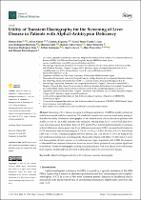Utility of Transient Elastography for the Screening of Liver Disease in Patients with Alpha1-Antitrypsin Deficiency
Author
Date
2021-04-16Permanent link
https://hdl.handle.net/11351/6743DOI
10.3390/jcm10081724
ISSN
2077-0383
WOS
000644471600001
PMID
33923569
Abstract
Screening of liver disease in alpha-1 antitrypsin deficiency (AATD) is usually carried out with liver enzymes, with low sensitivity. We conducted a multicenter cross-sectional study aiming to describe the utility of transient elastography for the identification of liver disease in patients with AATD. A total of 148 AATD patients were included. Among these, 54.7% were Pi*ZZ and 45.3% were heterozygous for the Z allele. Between 4.9% and 16.5% of patients had abnormal liver enzymes, without differences among genotypes. Liver stiffness measurement (LSM) was significantly higher in Pi*ZZ individuals than in heterozygous Z (5.6 vs. 4.6 kPa; p = 0.001). In total, in 8 (5%) individuals LSM was >7.5 kPa, considered significant liver fibrosis, and ≥10 kPa in 3 (1.9%) all being Pi*ZZ. Elevated liver enzymes were more frequently observed in patients with LSM > 7.5 kPa, but in 5 out of 8 of these patients all liver enzymes were within normal range. In patients with AATD, the presence of abnormal liver enzymes is frequent; however, most of these patients do not present significant liver fibrosis. Transient elastography can help to identify patients with liver fibrosis even with normal liver enzymes and should be performed in all Z-allele carriers to screen for liver disease.
Keywords
Alpha1-antitrypsin deficiency; Liver disease; Transient elastographyBibliographic citation
Pons M, Núñez A, Esquinas C, Torres-Durán M, Rodríguez-Hermosa JL, Calle M, et al. Utility of Transient Elastography for the Screening of Liver Disease in Patients with Alpha1-Antitrypsin Deficiency. J Clin Med. 2021 Apr 16;10(8):1724.
Audience
Professionals
This item appears in following collections
- HVH - Articles científics [4476]
- VHIR - Articles científics [1751]
The following license files are associated with this item:

 Private area
Private area Contact Us
Contact Us







